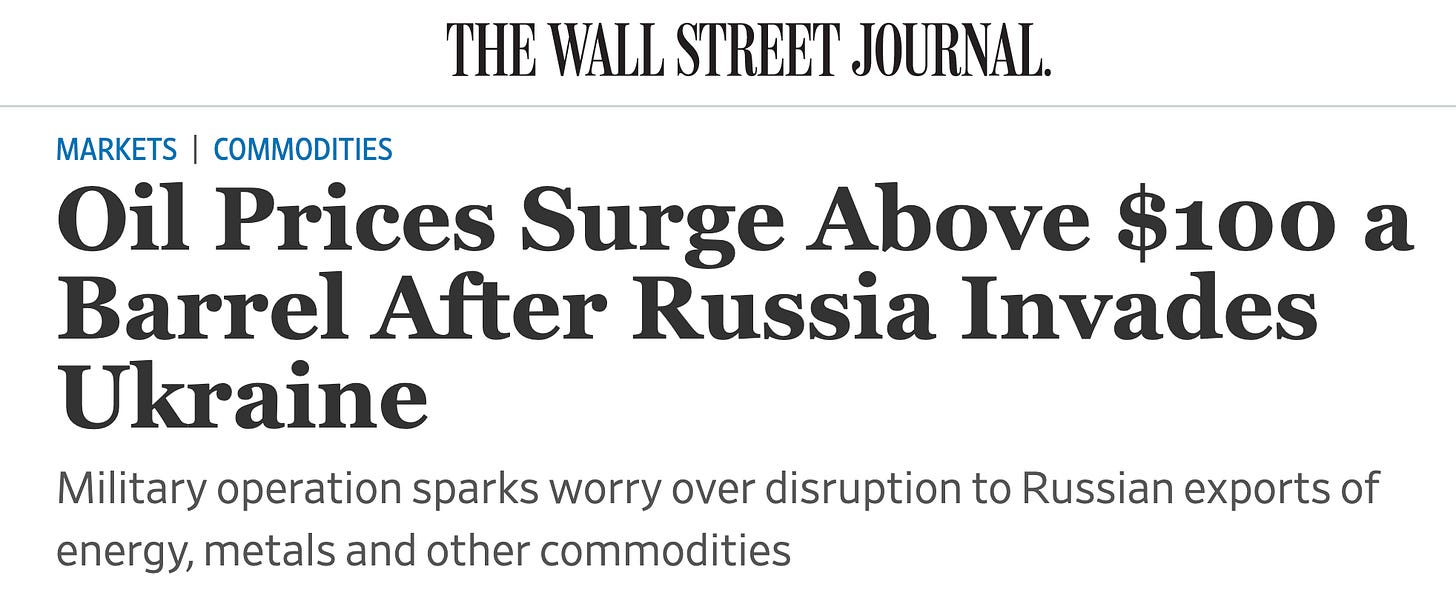Summary:
Negative Oil Price just 22 months ago
Over $100 a barrel today
Why is oil such a big deal?
Why the US
won’twill sanction Russian OilWill Wind and Solar replace oil?
Need to hear a different point of view?
The Solutions
Oil prices dip below zero as producers are forced to pay to dispose of excess
April 20, 2020
“US Crude fell to a negative value for the first time in history as stockpiles overwhelmed storage facilities, before rebounding to just over $1 on Tuesday.
Us oil prices turned negative for the first time on record on Monday after oil producers ran out of space to store the oversupply of crude left by the coronavirus crisis, triggering a historic market collapse that left oil traders reeling.
The price of US crude oil crashed from $18 a barrel to -$38 in a matter of hours, as rising stockpiles of crude threatened to overwhelm storage facilities and forced oil producers to pay buyers to take the barrels they could not store.
The market crash underlined the impact of the coronavirus outbreak on oil demand as the global economy slumps.
On Tuesday prices rebounded above zero, with the US benchmark West Texas Intermediate for May changing hands at $1.10 a barrel after closing at -$37.63 in New York on Monday.”
Just 22 months ago, the US benchmark West Texas Intermediate Oil price closed at minus $32.63 a barrel.
Feb. 24/2022:

Some say it still has a bit of room to increase in price. The price of oil affects all of us every day. It is just not the cost of gasoline, but did you know that so much of what we consume is made from oil or a petroleum product?
What is made from oil?
Personal Care Products
perfume, hair dye, cosmetics (lipstick, makeup, foundation, eyeshadow, mascara, eyeliner), hand lotion, toothpaste, soap, shaving cream, deodorant, pantyhose, combs, shampoo, eyeglasses, and contact lenses.
Medical Supplies
Products include hospital equipment, IV bags, aspirin, antihistamines, artificial limbs, dentures, hearing aids, heart valves and many more
Household Products
From construction materials such as roofing and housing insulation to linoleum flooring, furniture, appliances and home decors such as pillows, curtains, rugs, and house paint. Even many everyday kitchen items including dishes, cups, non-stick pans, and dish detergent use oil in their creation.
Where does all this oil and petroleum come from?
How much oil does the US import?
“The US Energy Information Administration (EIA) has published data for the amount of oil that the US imports. In November 2021, which is the last data set available, the US imported 254,162,000 barrels of oil. It consumes a stunning 17.2 million barrels per day, much more than just over 3 million of Russia.
The vast majority is from Canada, 136,090,000, making up over 50 per cent of oil imports. From Russia, 17,855,000 barrels were imported, with November’s imports being the lowest value of the year, but still 7 per cent of all imports.”
*In November 2021 the US imported nearly 18 million barrels of oil from RUSSIA!
March 8, 2022
Biden has now committed to stopping imports from Russian oil. Seems that the country is very concerned about gasoline price increases. The Biden administration has approved the release of 30 million barrels of oil from the Strategic Petroleum Reserve, and hinted that more may be released in the near term to offset these Russian import deficits.
The US wouldn’t have had to import any oil from Russia if Biden hadn’t cancelled the Keystone XL Pipeline on his first day as the new President.
June 9, 2021
“BILLINGS, Mont. – The sponsor of the Keystone XL crude oil pipeline said Wednesday it is pulling the plug on the contentious project after Canadian officials failed to persuade President Joe Biden to reverse his cancellation of its permit on the day he took office.
Calgary-based TC Energy said it would work with government agencies “to ensure a safe termination of and exit from” the partially built line, which was to transport crude from the oil sand fields of western Canada to Steele City, Nebraska.
Construction on the 1,200-mile pipeline began last year when former President Donald Trump revived the long-delayed project after it had stalled under the Obama administration.
It would have moved up to 830,000 barrels (35 million gallons) of crude daily, connecting in Nebraska to other pipelines that feed oil refineries on the U.S. Gulf Coast.” (source)
OK. How can we get away from using so much oil? The guys over at the ‘All In Podcast’ think all we have to do is to build wind and solar to replace all that oil.

That may be hopeful thinking for Chamath, one of the “Besties” on the All In Podcast”. Chamath Palihapitiya, founder and chief executive officer of Social Capital just invested 100’s of millions of dollars in the company Palmetto Clean Technology, which now has a $1 billion valuation.
“Palmetto Clean Technology, a home solar and energy company, raised about $375 million in a funding round led by Chamath Palihapitiya’s Social Capital.
Social Capital Invested about $220 million in the round, which closed last year. That’s the firm’s biggest single investment, Palihapitiya said in an interview Thursday. The fundraising values Palmetto at more than $1 billion, according to people familiar with the transaction, who asked not to be identified as the details aren’t public.”
So is Solar and Wind the answer to the higher oil and gas prices, as the mega-millionaires on the All In Podcast have suggested?
While there are so many unanswered questions about what Solar and Wind will cost and accomplish in the future, we can look back and see if recent history has an answer to this problem.
From Ontario, Canada
Trudeau government should learn from Ontario’s green energy failure
“Ontario’s auditor general concluded that guaranteed-price energy contracts with renewable generators caused Ontarians to pay $9.2 billion more than they would have paid for electricity under the provinces’ previous system.
To make matters worse, since electricity from wind and solar can’t be stored, Ontario has been forced to export its surplus electricity from renewable sources to neighbouring jurisdictions at a loss. In fact, according to the provinces auditor general, subsidized power exported to neighbouring jurisdictions cost Ontarians $1.3 billion between 2005 and 2011.”
Germany
https://www.americanexperiment.org/germanys-energy-disaster-20-years-later/
Germany’s Energy Disaster 20 Years Later
“When it comes to energy policy, legislators in Minnesota often cite Germany as an example of a shining star on a hill. This fondness for Germany probably stems from the taxpayer-funded trips that lawmakers take to experience the German Energiewende, or “Energy Transition”.
The ironic thing about their love affair with Germany is that the country’s experiment with wind and solar power has been a total disaster, resulting in skyrocketing electricity prices and a failure to produce an electric grid that emits less carbon dioxide than the United States.”
Spain
Spain’s solar energy crisis: Thousands of Spaniards bankrupt after investing in solar panels
Mon. Feb 21, 2022
“Seventeen years ago, Spain’s socialist government decided to inject subsidies into renewable energy. As a result, thousands of Spanish families massively invested in photovoltaic energy. But, as you’ll see in our report, the dream rapidly turned into a nightmare.”
Consider
https://www.amazon.ca/Unsettled-Climate-Science-Doesnt-Matters/dp/1950665798/ref=sr_1_1
“Steve Koonin is more than eminently qualified in climate science. He has degrees from Caltech and MIT; he is an author of over 200 academic papers; he was previously provost at Caltech and chief scientist for BP. Koonin, in short, is a brilliant physicist who worked and interacted with his colleague at Caltech, Richard Feynman, one of the greatest physicists of the twentieth century.
But what sets Koonin apart from other prominent climate sceptics are not his impeccable credentials. Happer and Lindzen have equally impressive CVs. But Koonin will be harder to vilify and “cancel” as other sceptics have been (here, here, and here) because he was appointed as Senate-confirmed Under Secretary for Science under the Obama administration serving from May 19, 2009, to November 18, 2011.
He served under a President who famously tweeted: “Ninety-seven per cent of scientists agree: Climate change is real, man-made and dangerous”. And this is precisely what Koonin’s book testifies against. It is quite wondrous how truth is told to power when one is released from the constraints of a government job.”
The answer to the fossil fuel energy problems going forward will be a combination of:
Bioenergy
Geothermal Energy
Hydropower
Nuclear Energy
Natural Gas
Wind
Solar
In no particular order.
What do you think? Are you team Thunberg or team Koonin?
Thanks, subscribers. Peace!






















Well done, Paul. I know the scale of research it took to put this together, then present it in such a logical, thoughtful manner.
I supported the pipeline all along. My feelings haven't changed. There are many reasons for this.... the details would be far to long to post here. Thanks for your post. With the war in Ukraine, this has been brought to a head.